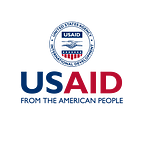Protecting the Earth Starts with Safety and Equality
A Q&A with USAID on how addressing gender-based violence and climate change is essential to building a safer and more equal world
In honor of 16 Days of Activism against Gender-Based Violence, which starts tomorrow and runs through Dec. 10, USAID reflects on how gender-based violence (GBV) is a barrier to conservation and achieving sustainable development goals. Rooted in gender inequality, gender-based violence discourages women’s participation in protecting and sustainably managing natural resources.
USAID communicator Natalie Lovenburg sat down with Chaitra Shenoy and Corinne Hart, USAID senior gender advisors, to discuss the importance of ensuring that women and girls can meaningfully participate in and lead on addressing and adapting to climate change. The Agency has countless partnerships and extensive programs to economically and intellectually empower women to leverage their know-how and expertise to increase climate resilience.
Why is the intersection of gender-based violence and climate change a focus for USAID?
Chaitra: One in three women worldwide will experience gender-based violence in her lifetime, and in some countries, that is true for 70% of women. Research shows that all kinds of gender-based violence — from sexual harassment, sexual and physical assault, economic violence, intimate partner violence, and early- and forced-child marriage — are happening in all types of natural resource management sectors, including energy and extraction, land and property rights, conservation, and climate change.
Corinne: Due to gendered differences, women, girls, and gender minorities face specific, life-threatening impacts after climate-related disasters. Their risk of gender-based violence escalates. For example, girls are sometimes forced into child marriage when families rely on this practice as a survival strategy during droughts. In 2019, after Cyclone Idai struck Mozambique, Malawi, and Zimbabwe, nearly 75,000 pregnant women had no access to clean water, sanitation, or reproductive health care; they were threatened by sexual assault, and harassment increased in camps. In 2016, in the aftermath of Cyclone Winston in Fiji, gender minorities were turned away from post-disaster shelters, increasing the risk of injury and death. At the same time, women and girls are leading the way in designing and implementing climate change solutions, and their valuable and unique knowledge on natural resource management and adaptation strategies are critical.
Chaitra: As a global leader in advancing gender equality, and in line with the U.S. Government’s Strategy to Prevent and Respond to GBV, as well as USAID’s Gender Equality and Women’s Empowerment Policy, USAID has an imperative to address GBV across the range of sectors in which it works. As we ramp up our efforts to address the global climate crisis, USAID is continuing to implement gender-equitable solutions and ensure that women and girls can meaningfully participate in and lead on addressing climate change.
What are some of the results you have seen from USAID’s gender-based violence prevention and response programming?
Corinne: The Advancing Gender in the Environment (AGENT) partnership between USAID and the International Union for the Conservation of Nature (IUCN) has recognized women as agents of change in the climate change sector for nearly a decade. Through AGENT, we conduct research and publish our findings on how climate change affects women, and help countries develop climate change gender action plans to ensure climate solutions are more effective and inclusive. USAID commissioned a research study in 2019, the first of its kind, to look globally at intersections of GBV and natural resource management, including climate change. Published in 2020, the study showed that gender-based violence is used as a means for natural resource control, and despite the pervasiveness of GBV-environment linkages, incidents are seldom documented and even more rarely explicitly addressed as part of environmental action, investments, or policymaking.
Chaitra: From that report, we decided to put resources towards a “challenge.” The USAID Resilient, Inclusive & Sustainable Environments (RISE) Challenge addresses the intersection of GBV and the environment. We fund organizations to innovatively adapt and implement promising or proven practices that have been used to effectively prevent and respond to gender-based violence in other sectors to environmental programming. USAID features interventions, facilitates access to funding and networking opportunities, and provides technical assistance to support the proposed activity in achieving measurable results and impact. Grantees focus on a range of environmental issues, including artisanal small-scale mining, land rights, and wildlife conservation.
What are future plans and partnerships to support this work?
Chaitra: USAID is funding the first-ever Gender-Based Violence and Environment Linkages Center (GBV-ENV Center) hosted by IUCN, which includes a curated online platform of resources and tools, mobilizes learning and cross-sectoral action, creates resources and shares them across a network of 3,000 plus practitioners, and provides technical assistance to environment projects seeking to address gender-based violence.
Corinne: USAID is committed to gender-responsive climate action. At the Generation Equality Forum, the White House demonstrated its commitment to gender equality through the creation of the Gender Equity and Equality Action Fund (GEEA), with climate as one of its priority sectors, underscoring the Biden-Harris administration’s commitment to inclusive, equitable climate action. When we invest in women as a key part of climate solutions, the entire world benefits.
About the Experts
Chaitra Shenoy is the Senior Gender-Based Violence Advisor and Team Lead in the USAID Bureau for Development, Democracy, and Innovation Gender Equality and Women’s Empowerment Hub. Corinne Hart is the Senior Gender Advisor for Energy and Environment and Team Lead in the same office.
